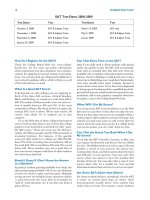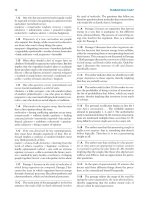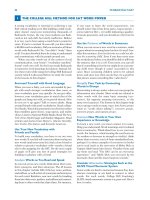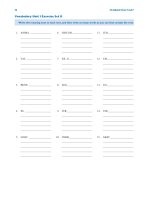Sat - MC Grawhill part 7 docx
Bạn đang xem bản rút gọn của tài liệu. Xem và tải ngay bản đầy đủ của tài liệu tại đây (232.33 KB, 10 trang )
GO ON TO THE NEXT PAGE
1. The number that is of 60 is what fraction
of 80?
(A)
(B)
(C)
(D)
(E)
8
9
3
4
1
2
1
3
1
6
2
3
2. If 4x + 2y = 8, then
(A) 0.25
(B) 0.5
(C) 1
(D) 2
(E) 4
xy+=
1
2
50 McGRAW-HILL’S SAT
7 7 777 7
SECTION 7
Time—20 minutes
16 questions
Turn to Section 7 of your answer sheet to answer the questions in this section.
Directions: For this section, solve each problem and decide which is the best of the choices
given. Fill in the corresponding circle on the answer sheet. You may use any available space for
scratchwork.
1. The use of a calculator is permitted.
2. All numbers used are real numbers.
3. Figures that accompany problems in this test are intended to provide information useful in solv-
ing the problems. They are drawn as accurately as possible EXCEPT when it is stated in a spe-
cific problem that the figure is not drawn to scale. All figures lie in a plane unless otherwise
indicated.
4. Unless otherwise specified, the domain of any function f is assumed to be the set of all real num-
bers x for which f(x) is a real number.
The number of degrees of arc in a circle is 360.
The sum of the measures in degrees of the angles of a triangle is 180.
Notes
r
A = πr
2
C = 2πr
ᐉ
w
A =
ᐉw V = ᐉwh V = πr
2
h
Special right triangles
c
2
= a
2
+ b
2
A =
1
/
2
bh
h
b
ᐉ
w
h
r
h
b
c
a
2x
x
x
s
s
s
3
2
30°
60°
45°
45°
Reference Information
CHAPTER 2 / DIAGNOSTIC SAT 51
7 7 777 7
GO ON TO THE NEXT PAGE
3. 29 apples, 21 pears, and 64 oranges are to be
distributed among three baskets, with each bas-
ket getting an equal number of apples, each
basket getting an equal number of pears, and
each basket getting an equal number of oranges.
If as much of the fruit as possible is distributed
in this way, what fruit will remain undistributed?
(A) 2 apples, 2 pears, and 1 orange
(B) 2 apples, 1 pear, and 1 orange
(C) 2 apples and 1 orange
(D) 1 pear and 1 orange
(E) 1 apple only
4. For all values of x and y, let x & y be defined by
the equation x & y = x(x − 1) + y(y − 1). What is
the value of 1 & 2?
(A) 1
(B) 2
(C) 3
(D) 4
(E) 5
5. In ΔABC, AB = 15 and BC = 9. Which of the
following could not be the length of AC?
(A) 5
(B) 7
(C) 9
(D) 16
(E) 22
6. What is the surface area of a cube that has a vol-
ume of 64 cubic centimeters?
(A) 64 square centimeters
(B) 96 square centimeters
(C) 256 square centimeters
(D) 288 square centimeters
(E) 384 square centimeters
7. The average (arithmetic mean) of x, 2, 6, and 10
is 8. What is the median
of x, 2, 6, and 10?
(A) 4
(B) 6
(C) 7
(D) 8
(E) 9
Note: Figure not drawn to scale.
8. In the figure above, PS = SQ and SQ = QT.
Which of the following expresses y in terms
of x?
(A)
(B) 90 − x
(C)
(D) 180 − 2x
(E) 180 − x
90
2
−
x
x
2
x°
y°
S
P
Q
7 7 777 7
GO ON TO THE NEXT PAGE
9. The graph above represents the set of all
possible solutions to which of the following
statements?
(A) ⎟ x − 1⎟ > 1
(B) ⎟ x + 1⎟ < 1
(C) ⎟ x − 1⎟ < 1
(D) ⎟ x + 1⎟ > 1
(E) ⎟ x + 1⎟ > −1
a > b
b < c
a = 2c
10. If a, b, and c represent different integers in
the statements above, which of the following
statements must be true?
I. a > c
II. 2c > b
III. ac > b
2
(A) I only
(B) II only
(C) I and II only
(D) II and III only
(E) I, II, and III
11. How many different positive three-digit inte-
gers begin with an odd digit and end with an
even digit?
(A) 125
(B) 180
(C) 200
(D) 225
(E) 250
12. A machine uses a laser beam to cut circles from
a sheet of plastic, as shown in the figure above.
The beam cuts at the rate of 3 cm per second.
If circle A has an area of 64 square centime-
ters and circle B has an area of 16 square cen-
timeters, how many more seconds will it take
the machine to cut circle A than circle B?
(A) 2π seconds
(B)
(C)
(D) 8π seconds
(E)
48
3
π
seconds
16
3
π
seconds
8
3
π
seconds
52 McGRAW-HILL’S SAT
-2-10123-3-4 4
CHAPTER 2 / DIAGNOSTIC SAT 53
7 7 777 7
Note: Figure not drawn to scale.
13. In the figure above, the slope of AC is the
opposite of the slope of CB. What is the value
of k?
(A) 9
(B) 10
(C) 12
(D) 14
(E) 15
14. If m is the product of all of the integers from 1
to 10, inclusive, and 2
n
is a factor of m, then
what is the greatest possible value of n?
(A) 2
(B) 4
(C) 8
(D) 16
(E) 32
15. An equilateral triangle with area square
centimeters is divided into two triangles by the
bisector of one of its angles. What is the sum of
the perimeters of these two triangles?
(A)
(B)
(C)
(D)
(E)
16. A culture of bacteria doubles in population
every 2 hours. A sample of 100 bacteria grows
to 1,000 bacteria by 4:00 p.m. At what time
were there 250 bacteria in this sample?
(A) 11:30 am
(B) 12 noon
(C) 12:30 pm
(D) 1:00 pm
(E) 2:00 pm
36 18 3+
36 12 3+
36 6 3+
18 9 3+
18 6 3+
36 3
O
x
y
C (8, 5)
B (k, -1)A (1, -1)
STOP
If you finish before time is called, you may
check your work on this section only. Do not
turn to any other section of the test.
GO ON TO THE NEXT PAGE
1. To Clara’s relief, the biopsy revealed that the
tumor on her skin was
(A) malignant
(B) irreverent
(C) serene
(D) benign
(E) mortal
2. The speaker’s message was by jargon that
rendered it decipherable only to those few au-
dience members familiar with her particular
area of expertise.
(A) elated
(B) revealed
(C) obscured
(D) enlightened
(E) consoled
3. To those consumers who are more influenced by
style than by performance, the value of the
sports car outweighs its functional flaws.
(A) utilitarian
(B) pragmatic
(C) approximate
(D) aesthetic
(E) inexplicable
4. A student becomes a thinker only when he or
she realizes that most so-called facts are merely
claims, each serving its purpose only
temporarily.
(A) provisional
(B) polemical
(C) authoritative
(D) dramatic
(E) pedantic
54 McGRAW-HILL’S SAT
8 8 888 8
SECTION 8
Time—20 minutes
19 questions
Turn to Section 8 of your answer sheet to answer the questions in this section.
Directions: For each question in this section, select the best answer from among the choices given and
fill in the corresponding circle on the answer sheet.
Each sentence below has one or two blanks,
each blank indicating that something has been
omitted. Beneath the sentence are five words
or sets of words labeled A through E. Choose
the word or set of words that, when inserted
in the sentence, best
fits the meaning of the
sentence as a whole.
EXAMPLE:
Rather than accepting the theory unquestion-
ingly, Deborah regarded it with
.
(A) mirth
(B) sadness
(C) responsibility
(D) ignorance
(E) skepticism
A
C D
E
B
CHAPTER 2 / DIAGNOSTIC SAT 55
8 8 888 8
GO ON TO THE NEXT PAGE
deep understanding that human life is perhaps
the ultimate gift of nature or God. This gift is
made even more profound by the fact that we
ourselves are not only its recipients but also its
conduits: we receive life and we help create it.
But our participation in the creation of life must
never be misconstrued as control. Rather, we
must be humbled by the power of the life force
at the moment of conception.
The idea of “outsourcing” the creation of
human life, of relegating it to a laboratory, of
reducing the anticipation of childbirth to a trip
to the mall or a selection from a catalog, leaves
us with a profoundly hollow feeling. The mys-
tery is replaced by design; the surrender to
nature is replaced by arrogant control. Should
we turn our noses up at one who would offer us
the most precious gift in the universe, only to
say: “Sorry, but I think I can do better?”
Cloning is the engineering of human life. We
have for the first time the ability to determine
the exact genetic makeup of a human being, to
thwart the essential random (or seemingly ran-
dom) processes that form the basis of natural
selection, to employ unnatural selection. A child
can be created that is no longer a unique cre-
ation but the end product of an assembly line,
with carefully designed and tested features. Are
the astonishing products of natural selection
that we find around us somehow deficient? Are
we so full of hubris
1
as to think we have a
better way than nature or God?
If human cloning becomes acceptable, we will
have created a new society in which the essence
of human life is marginalized. Industries will
arise that turn human procreation into a prof-
itable free-market enterprise. The executive
boards of these companies, rather than nature or
God, will decide the course of human evolution,
with more concern for quarterly profit reports
than for the fate of humanity.
5. Traditionally, the role had been played demurely
to provide a foil for the bolder personalities in
the play, but Ms. Linney has decided to
convention and emphasize her character’s
(A) respect . . bluster
(B) abandon . . solitude
(C) forgo . . coyness
(D) uphold . . bombast
(E) eschew . . impudence
6. Despite the attempts of popular analysts to
depict the stock market as driven by pre-
dictable financial principles, an increasing
number of investors believe that the price of
any security is
(A) invaluable
(B) complacent
(C) capricious
(D) responsive
(E) obscure
The passages below are followed by questions
based on their content; questions following a
pair of related passages may also be based on
the relationship between the paired passages.
Answer the questions on the basis of what is
stated
or implied in the passage and in any
introductory material that may be provided.
Questions 7–19 are based on the following passages.
Since 1996, when scientists at the Roslin Insti-
tute in England cloned a sheep from the cells of
another adult sheep, many inside and outside the
scientific community have debated the ethics of
cloning the cells of human beings. The following
passages are excerpts of arguments on this issue.
PASSAGE 1
With the specter of human cloning looming on
the horizon, the dominant ethical question is:
what is a human being? Until now, our respect
for human life has rested fundamentally on the
1
Excessive pride or arrogance
5
10
15
20
25
30
35
40
45
Line
8 8 888 8
GO ON TO THE NEXT PAGE
These are not idle concerns. Even as we pon-
der the ethical implications of human cloning,
companies are forging ahead with the cloning
of human stem cells for seemingly beneficial
purposes, marching steadily toward a Brave
New World
2
in which humanity will be forever
different from what it is today.
PASSAGE 2
The irrational fears about human cloning that
abound from all parts of the political spectrum
should not surprise anyone who knows a little
bit about the history of technology. Hardly
anything significant has been invented that no
segment of the population has denounced as
evil: factories, trains, automobiles, telephones,
televisions, computers. Not even medicine has
been spared this vituperation, despite its obvi-
ous benefits to humanity. Before the merits of
surgery became obvious, it was unimaginable
that slicing the flesh of a human being could do
more harm than good.
At first glance, it might seem that cloning is a
whole new ballgame. After all, cloning is “the en-
gineering of human life,” isn’t it? It is the mass
production of designer babies. It is the end of
evolution, or at least the beginning of its corpo-
rate management. It is certainly a slap in the face
of God. Or is it?
One of scariest things to the opponents of
cloning is the prospect of human beings having
identical genetic codes. As cloning foe Jeremy
Rifkin has said: “It’s a horrendous crime to
make a Xerox of someone. You’re putting a
human into a genetic straitjacket.” Logically,
then, Mr. Rifkin must be repulsed by natural-
born identical multiples: there is no scientific
way to distinguish the DNA of one’s identical
twin from that of one’s clone. Perhaps the whole
system of natural human procreation is sus-
pect, if it is capable of occasionally churning
out such monstrosities.
We need nothing more than the most rudi-
mentary common sense to see how vacuous
such an argument is. We all know identical
twins who have their own unique thoughts,
talents, experiences, and beliefs. They are not
horrendous monsters. Human beings are more
than merely their DNA; they are the products of
the continual and inscrutably complex inter-
actions of environment and biology. Human
clones would be no different.
The most common objection we hear from
the anti-cloning lobby is that those who would
clone human beings are “playing God,” and
trespassing into territory that can only bring the
wrath of nature or its creator. Most of these
arguments are basically theological, and rest on
the most effective tool of human control ever in-
vented: fear of God. We can easily get people to
hate something by calling it “unnatural.” But
this argument is even more easily demolished
than the previous one, because it falls so easily
in line with so many obviously silly claims. This
argument rests on the assumption that human
ingenuity has essentially no value, that improv-
ing on nature is the height of hubris. This is the
reasoning of the Dark Ages. Nature presents veg-
etables and meats only in raw form, so isn’t the
cooking of food a human transgression against
nature? Nature gives us feet, not wheels, so
aren’t bicycles evil? If we were to abandon all of
the “unnatural” practices and products from
our lives, we would be shivering in caves eating
uncooked leaves and bugs.
Maybe human procreation is a different arena,
however, more sacred than all of the others. But
then, why have the technologies of fertility
enhancement, in vitro fertilization, embryo
transfer, and birth control become so widely
accepted? They are telling examples: each of
these procreational technologies had legions of
vocal opponents—at first—but over time the
protests mellowed as people realized that the sky
wouldn’t fall after all. Familiarity dissipates fear.
What most opponents of genetic technology
don’t realize is that their supposedly “moral”
objections are impeding true moral progress.
With genetic engineering and stem cell research,
scientists finally have within their grasp tech-
nologies that can produce ample food for a
starving world and cure devastating illnesses.
Only ignorant superstition stands in their way.
56 McGRAW-HILL’S SAT
2
A futuristic novel by Aldous Huxley that describes the mass pro-
duction of genetically identical human babies
50
55
60
65
70
75
80
85
90
95
100
105
110
115
120
125
130
135
CHAPTER 2 / DIAGNOSTIC SAT 57
8 8 888 8
GO ON TO THE NEXT PAGE
7. The “control” mentioned in line 11 is control
over
(A) the effects of cloning
(B) the development of genetic technologies
(C) the process of conception
(D) the moral debate about cloning
(E) activities in a laboratory
8. Which of the following best describes the
attitude of the author of Passage 1 toward
“outsourcing” (line 14)?
(A) reluctant approval
(B) disdain
(C) strong support
(D) ironic detachment
(E) ambivalence
9. The statement “sorry, but I think I can do
better” (line 23) is intended to represent a
comment from
(A) a religious person to a nonreligious person
(B) an opponent of cloning to a scientist
(C) a voter to a politician
(D) the author to the reader
(E) an advocate of cloning to nature or God
10. The parenthetical comment in lines 27–28 is
intended to account for the possibility that
(A) life might be designed by a power
beyond humanity
(B) cloning technologies might become
uncontrollable
(C) two human beings might have the same
genetic makeup by chance alone
(D) some scientific theories might not be
reliable
(E) cloning technology might not succeed
11. Passage 1 mentions which of the following as
elements of “unnatural selection” (line 29)?
I. mechanical procedures
II. random processes
III. selection of characteristics
(A) I only
(B) III only
(C) I and II only
(D) I and III only
(E) I, II, and III
12. In the first paragraph of Passage 2, the author
suggests that the opponents of human cloning,
as a group, are all of the following EXCEPT
(A) very religious
(B) unreasonable about the implications of
cloning
(C) from widely varied political orientations
(D) ignorant of scientific history
(E) fearful of new ideas
13. Surgery is mentioned in lines 62–65 as an
example of
(A) a practice that requires a great deal of
education
(B) something that most people still fear
(C) a medical technology that was once
denounced
(D) a viable alternative to genetic technologies
(E) a skill in need of more practitioners
8 8 888 8
14. The author of Passage 2 quotes Jeremy Rifkin
(lines 76–78) in order to
(A) illustrate the dangers of cloning
(B) show a well-reasoned perspective
(C) indicate an illogical claim
(D) represent the views of medical
professionals
(E) show how others support the author’s
thesis
15. The author of Passage 2 mentions that identi-
cal human twins “have their own unique
thoughts” (line 89) in order to suggest that
those twins
(A) would likely oppose human cloning
(B) are not simply the product of their DNA
(C) are among the most vocal advocates of
cloning
(D) are able to provide alternatives to
procreational technologies
(E) are less likely to be swayed by illogical
theories
16. Passage 2 suggests that those individuals who
had previously denounced “procreational
technologies” (line 125) have since come to
accept them because those individuals
(A) became more familiar with the
technologies
(B) realized that the technologies were
indeed “natural”
(C) understood the theories behind the
technologies
(D) realized that the technologies were
inexpensive
(E) themselves needed to use those
technologies
17. The tone of the last paragraph of Passage 2 is
best described as
(A) indignant
(B) analytical
(C) resigned
(D) humorous
(E) whimsical
18. Which of the following best describes the rela-
tionship between the pair of questions pre-
sented in Passage 1 (“Are the astonishing
products . . . nature or God?” [lines 32–36]) and
the pair of questions presented in Passage 2
(“Nature presents . . . evil?” [lines 111–115])?
(A) The first two are not intended to be
answered, while the second two are.
(B) The first two are scientific questions,
while the second two are moral
questions.
(C) Both pairs of questions indicate points of
view criticized by their respective authors.
(D) The first two are intended as questions
from cloning opponents, while the
second two are intended as questions
from cloning advocates.
(E) The first two are common questions, the
second two are asked only by experts.
19. The last paragraphs of both passages indicate
that both authors share what assumption?
(A) Cloning needs more scientific study.
(B) Genetic engineering will have profound
global effects.
(C) Cloning will marginalize human life.
(D) Procreational technology can benefit the
poor.
(E) Scientists are ill-suited to make moral
decisions.
58 McGRAW-HILL’S SAT
STOP
If you finish before time is called, you may
check your work on this section only. Do not
turn to any other section of the test.
CHAPTER 2 / DIAGNOSTIC SAT 59
GO ON TO THE NEXT PAGE
9 9 999 9
SECTION 9
Time—10 minutes
14 questions
Turn to Section 9 of your answer sheet to answer the questions in this section.
Directions: For each question in this section, select the best answer from among the choices given and
fill in the corresponding circle on the answer sheet.
The following sentences test correctness and
effectiveness of expression. Part of each sen-
tence or the entire sentence is underlined;
beneath each sentence are five ways of phras-
ing the underlined material. Choice A repeats
the original phrasing; the other four choices
are different. Select the choice that completes
the sentence most effectively.
In making your selection, follow the require-
ments of standard written English; that is, pay
attention to grammar, choice of words, sen-
tence construction, and punctuation. Your
selection should result in the most effective
sentence—clear and precise, without awk-
wardness or ambiguity.
EXAMPLE:
The children couldn’t hardly believe their eyes
.
(A) couldn’t hardly believe their eyes
(B) could hardly believe their eyes
(C) would not hardly believe their eyes
(D) couldn’t nearly believe their eyes
(E) couldn’t hardly believe his or her eyes
1. One way to improve the effectiveness of the
treatment is by moving the source of radiation
more closely to the patient.
(A) by moving the source of radiation more
closely
(B) to move the source of radiation more
closely
(C) to move the source of radiation closer
(D) in moving the source of radiation closer
(E) to move more closely the source of
radiation
2. Until becoming more affordable by standard
iz-
ing its technology, cell phones were quite rare.
(A) Until becoming more affordable by
standardizing its technology
(B) Having become more affordable through
standardizing their technology
(C) Becoming more affordable through
standardized technology
(D) Until they became more affordable in
standardized technology
(E) Until standardized technology made
them more affordable
A
C D
E
B









